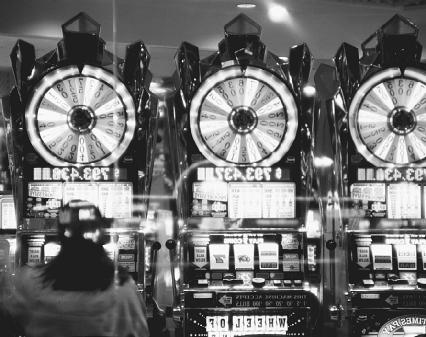Habits and Behaviors - Compulsive behaviors
Compulsions are habitual behaviors or mental acts an individual is driven to perform in order to reduce stress and anxiety. Individuals can fall victim to compulsive behaviors that make them feel a craving similar to that of drug addicts and alcoholics. Just like addiction to drugs and alcohol, this kind of compulsion can affect anyone. Psychological vulnerability, cultural and social factors, and contact with others engaging in compulsive behaviors all play a role in whether an individual will become addicted to a certain activity.

It is important to note that any of the following activities or behaviors in moderation is fine. It is when normal activity begins to affect a person's quality of life that it may be turning compulsive.
Gambling
Gambling can be a dangerous compulsion. Compulsive gamblers often spend all their money, their savings, and even resort to stealing money from loved ones to support their habit. People can get addicted to betting on sports events, playing poker, or playing slot machines in bars and casinos. Something about the possibility of winning, perhaps the risk and the consequent adrenaline rush, spur on the compulsive gambler. Now there is even online gambling. Virtual casinos are immediately available to those who cannot travel to popular gambling destinations like Las Vegas, Nevada, or Atlantic City, New Jersey. The Center for Online Addiction (www.netaddiction.com) exists to serve people with all forms of Internet addiction, including addiction to online gambling. Addiction to online auction houses, such as E-bay, is another form of compulsive gambling. Online traders, people who trade stocks on the Internet, can also fall victim to compulsive trading.
Internet Addiction
Internet addiction is a broad term that describes many kinds of compulsive behaviors. Many of the things that individuals can become addicted to in real life are replicated on the Internet. The reason internet addictions are a bit more dangerous is that people often feel secluded sitting in front of their computer screens. There is a sense that they won't get caught in the act.

According the Center for Online Addiction, there are five types of Internet addiction:
- Cyber-sexual addiction is an addiction to adult chat rooms or cyber-porn.
- Cyber-relationship addiction is addiction to meeting people on the Internet, usually in chat rooms or through newsgroups. People who grow addicted to meeting people in the virtual world often stop seeing and speaking to their friends from real life.
- Net compulsions are the gambling-related activities mentioned above.
- Information overload is compulsive web surfing and researching. Sometimes information overload can keep people up all night surfing, which impacts normal daily activities.
- General computer addiction describes those who compulsively play video games or program their computers.
People who hide out in a cyber universe are often troubled and have difficulty socializing with real people. Counseling is suggested to help Internet addicts come out from behind their computers and rejoin the real world.
Exercise Addiction
Exercise addiction is compulsively exercising to the point of damaging a person's health. Is it possible to be addicted to a seemingly healthy behavior? Anything done in excess is dangerous, even if it is taking vitamins or exercising. Individuals addicted to exercise want to do it all the time. They think about exercise constantly, and plan their every moment around the next time they can run, bike, take a class at the gym, or lift weights. They talk constantly about fitness. They begin to associate only with those people who will indulge their addiction: those who also exercise all the time. If someone gets really angry or depressed by missing a workout, or if he or she constantly exercises and stops taking part in other social activities, that individual might be an exercise addict.
Exercise addiction can lead to exhaustion and death. Women can stop getting their periods, and men who are obsessed with muscles sometimes succumb to taking dangerous steroids to bulk up. For most people, a new exercise regimen, often under the supervision of a doctor or a trainer, is truly beneficial to their health. But in some cases, people become so addicted to their regimen that they cannot stop. The healthful benefits of exercise get lost within the desperate need to be exercising all the time.
Often exercise addiction is related to body image disorders, like anorexia nervosa, bulimia nervosa, and body dysmorphic disorder. In all three of these illnesses, the individual sees herself not as she is, but as a distorted, fat person who does not measure up to society's standards of thinness. (In the case of body dysmorphic disorder, fat is not always the culprit but rather a constant unhappiness with parts of or the shape of one's body.) Women and girls tend to suffer from this kind of disease most often, but boys and men are not exempt.
Exercise addiction can develop for other reasons as well. For instance, athletes can become addicted to training in their quest to improve their performance. Abuse of steroids can result from exercise addiction. Steroids are a class of drugs that increase the male hormone testosterone in the body. This increases muscle mass when accompanied by weight training. In the weight lifting world, there is a focus on looking "buff" or very muscular. Many men (women, too) who weight train sometimes become so focused on the goal of attaining huge muscles that they turn to steroids and other artificial means of bulking up.
[See Chapter 12: Mental Illness for more information on body dysmorphic disorder. See Chapter 13: Eating Disorders for more information on exercise addiction and eating disorders.]
Self-Mutilation
Self-mutilation, also known as cutting, is a form of obsessive-compulsive disorder. Self-mutilators tend to be teenage girls, but anyone can have this compulsion. People who self-mutilate often get a high off of seeing their own blood. They sometimes carve on their body with razor blades, stick themselves with pins, and squeeze and pinch their faces. Depression is a common cause for self-mutilation. Many self-mutilators physically hurt themselves to disguise some emotional pain they might be trying to repress. Self-mutilators are not necessarily suicidal, but the fact that they draw blood from their bodies makes outsiders think so. It is important that self-mutilators receive therapy to uncover the reasons why they are hurting themselves.
Manias
A mania is an excessive or unreasonable enthusiasm for something, especially something destructive such as stealing or starting fires.
Kleptomania is the compulsion to steal. Kleptomaniacs lead dangerous lives, stealing things every chance they get. It's not enough for them to simply shoplift from stores. Kleptomaniacs steal from their friends, teachers, and loved ones. Similar to gambling, something about the risk of getting caught gives these individuals a kind of high.
Pyromaniacs are compelled to start fires. This compulsion can kill not just the individual who sets the fire, but anyone caught in the way. Often this compulsion begins in young people who for some reason feel as if they didn't get enough attention as a child. Pyromaniacs are often angry people, but the anger is often suppressed. Setting fires is a way for them to express their anger. Usually pyromaniacs don't get help until it is too late. A serious fire is often what finally gets them into therapy.
Compulsive Shopping
Compulsive shopping is a behavior that was first given media attention in the 1990s. People with this addiction run up their credit card bills and get so buried in debt that they sometimes have to declare bankruptcy (legally declared unable to pay one's bills due to lack of money). Many people, at one time or another, purchase an item that they do not really need or want. Compulsive shoppers, however, will go on frequent shopping sprees and buy many things that they just don't need at all. Somehow, standing in front of the item before they buy it, they believe that their lives will be better if they own the item. As a result, they end up with closets full of unnecessary items.
Compulsive shoppers are searching for love in the form of material objects. They think that things will provide them with the emotional lack in their lives. Often they will continue going on shopping binges until a loved one stops them or they lose everything to debt. A self-motivated method for stopping compulsive shopping is putting credit cards into a block of ice in the freezer. Then the individual desiring to shop will have to wait until the ice melts to retrieve the card, and hopefully the compulsion will have passed by that time. Professional help is suggested for those individuals who cannot control shopping binges.
Sex Addiction
Sex addiction is the compulsion to repeatedly seek out people and have sexual intercourse with them. Sex addicts put themselves in dangerous situations regularly just to fulfil their need to have sex with someone. People who are sex addicts sometimes meet strangers in bars, or almost anywhere, and go someplace with that stranger to engage in casual sexual activity. Of course, when a stranger is involved there is a great deal of danger from potential personal harm. People who engage in such behaviors are not just being promiscuous; rather, they are psychologically driven to their sex addiction.
Sex addiction is treatable. Once addicts confront and accept their behavior, they can begin to look at the reasons why they are compelled to have sex all the time. Often sex addicts experienced sexual abuse as children. Their sex addiction is a way of having control over their bodies and the act of seduction they compulsively perform is a way of having control over a partner. Sex addiction is never connected to healthy love and desire.
A strong self-image is the first defense against any type of addiction. Many of the habits and behaviors discussed in this chapter are not alarming if imagined in small doses. A cup of coffee, a candy bar, running for good health, or sexual activity isn't dangerous if it is treated as a simple desire that can be fulfilled and then forgotten about. (However, the mind-altering drugs and alcohol discussed in this chapter can be dangerous, even if they are just experimented with even one time.) It is most important to remember that if one has a strong sense of self and a strong support system, addiction is far less likely to result from experimentation.

Comment about this article, ask questions, or add new information about this topic: